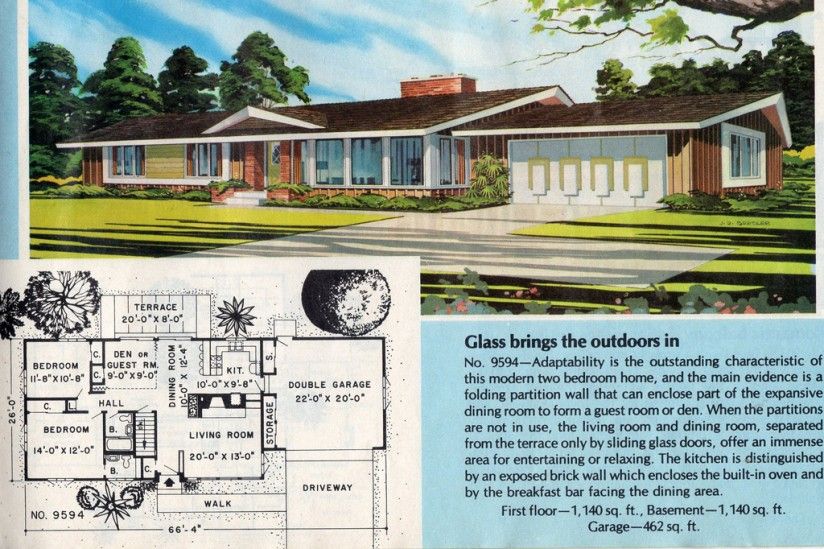My husband and I watch a lot of HGTV. We predict whether homeowners will Love It or List It; we marvel at the amount of work that gets done on Flip or Flop. On one episode of Property Brothers, one of the hosts asked the homeowners with humor, “What do you even call this style?” To be fair, the word “style” itself might have been generous among their son’s sports clutter, the wife’s expansive knickknack collection, and the husband’s beloved man-cave. It reminded me of my own decorative style in the 15 years of apartment living between college and home ownership, a style my dad lovingly coined “early poverty.”
Homeownership changed all of that. The first home I bought for myself on the north side of Indianapolis actually did have a style, a style with an official name: mid-century modern. And though I am certainly no modernista myself, I soon found that the style fit me. But not for the reasons I would have expected.
In the years after World War II, politicians and world leaders weren’t the only ones looking for a new way to see the world. Architects and designers, influenced by the “organic architecture” of Frank Lloyd Wright, as well as the German Bauhaus movement, began incorporating features like floor-to-ceiling windows and sliding glass doors into residential designs as a way for families to interact with the world from the privacy of their home. No one had smart phones or laptops in those post-war days. Few people even had televisions. But these “windows to the world,” along with open-concept floor plans, hinted at the degree to which people would increasingly conduct themselves vocationally, socially, economically, politically—even spiritually—without ever leaving the house.
According to Dinah Eng in her FrontDoor.com post, “All About Mid-Century Modern Architecture,” these creative home designers “believed the forward-looking style could be a vehicle for social change to create a better society. Characterized by flat planes, large glass windows and open space, these homes — built from 1945 to the 1980s — featured simplicity and an integration with nature, encouraging residents to explore the world in new ways.”
The neighborhoods themselves also were designed for healthful living, the promise of the burgeoning suburbs in the post-war days. While the suburban dream feels more like a nightmare to many young urbanites today, the wide open lots just outside city limits became necessary infrastructure to support the strong horizontal lines of the mid-century designs and an appealing refuge from the cost, decay, and increasing violence of urban life.
My mid-century modern house was built in 1959 in a thriving middle class suburb. Forty-seven years later, I bought it on the cheap in an estate sale, its limestone and brick exterior still pristine despite its age. Twelve months after that, I was diagnosed with stage four cancer.
For weeks I endured extreme nausea, fatigue, hair loss, and weight loss resulting from cancer treatments that were supposed to heal me. They felt like they were killing me. Each night, as I made my way to the bedroom, it was like a march of death. Would I die in the darkness of that back room, overcome by anxiety and pain?
Eventually, I stopped going to bed at all, passing the nights, and most days, lying on the couch. The floor-to-ceiling windows and the open concept living room and kitchen directly connected me to the outside world of both my front and back yards, just as the designers had envisioned. I watched snow and rain and wind and sun. Birds and squirrels and rabbits were within my view, as well as the mail carrier and utility workers and neighbors speeding along in cars on their way to work or church or the grocery. Light came into the house, turning the flat, white walls orange and pink and green and blue depending on the sky and the sun and the canopy of trees.
During my years in the house, the city caught up with my suburban neighborhood. Many of the other mid-century modern homes up and down the street are on the auction block. Vacant for years, they will likely be razed and converted to apartments or town homes or worse: cheap, prefab neighborhoods. I had to sell my own home last year after moving in with my new husband an hour from the city.
The mid-century designers never expected their post-war homes to be temporary dwellings, replaced cheaply in just a few decades. But they also could not have pictured that the light of those floor-to-ceiling windows and the open-concept floor plan would nurse a woman back to health from cancer. Light shining through the sliding glass gave birth to hope, and the sturdiness of the limestone reminded me again and again that though time changes things—cities grow, neighborhoods fall, bodies age—what remains makes us strong.




